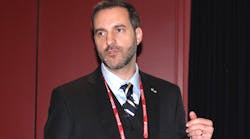“On a typical greenfield project with greater than $85 million spend on automation, it saves about $10 million.” Wood’s Alexander Kebaili on the savings created through the use of integrated solutions based on Rockwell Automation’s PlantPAx DCS and AAdvance SIS platform.
Whether they’re greenfield installations or existing plants, oil & gas facilities can take advantage of new approaches for system design, engineering, testing, installation and commissioning being made possible by PlantPAx and virtualization, according to Alexander Kebaili, business development manager, Wood.
Kebali co-presented “Solving oil & gas challenges, providing seamless integration, efficiency, reliability” with Alejandro Lupane͂z, vice president, operations, Mexico, Wood, and Humberto Sanchez, technology consultant, Rockwell Automation. The potential savings in costs and time were illustrated using an ongoing greenfield project in Mexico at the Rockwell Automation 2019 Process Solutions User Group (PSUG) meeting this week in Chicago.
The terminal project is for a large independent producer and includes one marine and two inland terminals, with five more coming. “We just had a successful field acceptance test (FAT) of the three facilities last month, and expect commercial start-ups in the first half of 2020,” Kebaili said.
These are the client’s first liquid terminal projects, and they were looking for an experienced system integrator with customer references in North America and particularly, Mexico. The technology and quality were very important, and delivery times are always critical. “They also want post-sale service and a maintenance warranty through the asset lifetime, so we had to demonstrate that we’d be around,” Kebaili said. “There was a complex environment of stakeholders to manage—vendor, integrator, EPC, client and end user—and the requirement to deliver the lowest total cost of ownership, with safety.” The project integrated well over 10,000 signals.
Wood is a global leader in technical engineering and project services with 60,000 people in 60 countries, including 1,500-2,000 engineers dedicated to automation and control. The company focuses on infrastructure, industrial, mining, power and oil & gas, “with over half its revenues from oil & gas,” Kebaili said.
Wood projects cover from conceptual design to commissioning and post-startup support, and include “everything that is process control, telecommunications, cybersecurity and physical security,” said Kebaili. “Projects include and integrate third-party equipment—we are services, not product, oriented, and offer an integrated, turnkey solutions.
“Mexico’s market is number five in the world, with a lot of room to grow and a lot competition as well. Security is key, including infrastructure access, security and safety. Changing requirements led to scope creep and a lot of change orders on the three sites, which required Rockwell Automation and Wood to be flexible, to be a partner with the client and to manage shareholder expectations.”
Technology enables innovation
The solution chosen is based on Rockwell Automation’s PlantPAx DCS with virtualization for higher safety and cost-efficiency, and AADvance SIS for fire and gas (F&G) detection and emergency shutdown (ESD) systems. “In PlantPAx, virtualization is enabled through detailed sizing and architecture rules, virtual templates for easy deployment of servers preloaded with necessary operating systems and Rockwell Automation software, and an industrial data center that fully supports the virtual infrastructure hardware supported by Rockwell Automation,” said Sanchez.
PlantPAx virtual image templates include FactoryTalk AssetCentre for asset management, Studio 5000 for engineering workstations, FactoryTalk View for operator workstations, and FactoryTalk VantagePoint, FactoryTalk Historian and SQL Server information servers.
“The system includes one hot server and one for standby,” Unberto said. “Virtualization reduces system cost, extends the system lifecycle, enhances availability, and eases lifecycle management.” Using AADvance for F&G and ESD systems with ControlLogix gives all systems the same look and feel for operator familiarity.
Based on the results to date and the completed FAT, the approach is “resulting in customer satisfaction and schedule improvement,” Kebaili said. Compared to a conventional approach, Wood sees 10-20% lower capex costs due to reduced project management/project architecture (PM/PA), lower commissioning and hardware costs, and fewer change orders during commissioning. It’s also resulting in faster startup, “a one- to two-week improvement on a greenfield plant,” Kebaili said. “And on a typical greenfield project with greater than $85 million spend on automation, it saves about $10 million.”





